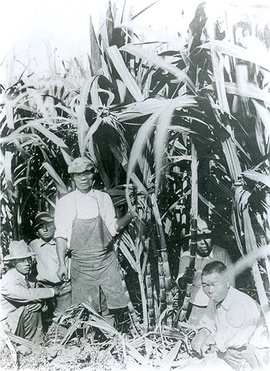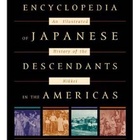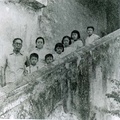Between 1885 and 1924, approximately 200,000 Japanese arrived in Hawai'i and 180,000 immigrated to the continental United States. Most were from the southern prefectures of Japan plagued by conditions of drought, famine, and overpopulation.

Kona men in sugar cane field of Hawai'i, date unknown. (Gift of Sukeji Yamagata. Courtesy of the Rev. Shugen Komagata. Japanese American National Museum [95.197.25])
In Hawai'i the early Issei worked on the sugar plantations; on the mainland the new arrivals were sent to salmon canneries in Alaska, mining camps in Utah, sawmills in Oregon, or the agricultural fields of California.
Ongoing Racism
Racism always played a part in the lives of the Nikkei, eventually bringing a halt to the entry of new laborers after the U.S.-Japan Gentlemen’s Agreement of 1907-08.
In the following decades, the composition of the Nikkei community shifted from single males to families, accompanied by achievements in Issei agriculture and renewed anti-Japanese attacks.
The denial of naturalization rights in 1922 and the termination of immigration from Japan in 1924 (both effective until 1952) delivered severe setbacks.
World War II: Internment & Military Honor
With the outbreak of the Pacific War, all people of Japanese descent living on the West Coast were removed from their homes and incarcerated, subject to mass removal and incarceration. To prove their loyalty, many American-born men served in the army or military intelligence service. Their heroic contributions helped the Nisei to break through racial barriers and gain rapid social mobility after the war. In Hawai'i the Nisei war veterans became a major political force, leading to statehood in 1959.

Nishi Hongwanji Buddhist Temple in Los Angeles’ Little Tokyo (currently the Historic Building of the Japanese American National Museum) became a roundup point for the Japanese Americans who were sent to "assembly centers" in 1942. (Jack Iwata photo. Gift of Jack and Peggy Iwata. Japanese American National Museum [93.102.102])
Redress
In the 1980s, the third-generation youth joined the Nisei in seeking redress for the injustices suffered by the internees during the war. The lengthy struggle ended in the passage of the redress law in 1988. Today the Japanese American community is more diverse than ever before, with changing boundaries and self-definitions, with many new immigrants and multi-racial Nikkei, but the ties that bind still remain strong.

On August 10, 1988, President Ronald Reagan signs the redress law, H.R. 442. (Gift of Norman Y. Mineta, Japanese American National Museum [96.370.16A])
Source:
Akemi Kikumura-Yano, ed., Encyclopedia of Japanese Descendants in the Americas: An Illustrated History of the Nikkei (Walnut Creek, Calif.: AltaMira Press, 2002), 275.
* Developed in collaboration with the Center for Oral History and Social Science Research Institute at the University of Hawai'i at Manoa and the Asian American Studies Center at the University of California at Los Angeles.
© 2002 Japanese American National Museum






